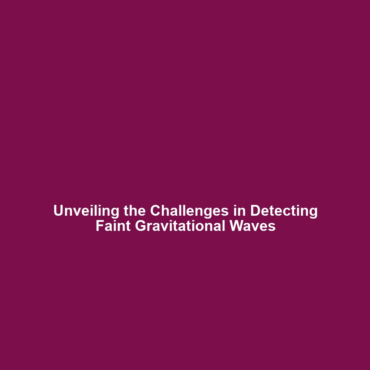Challenges in Detecting Faint Gravitational Waves
Introduction
Detecting faint gravitational waves presents a significant challenge within the ever-evolving field of gravitational wave research. As physicists and astronomers push the boundaries of our understanding of the universe, overcoming these detection hurdles becomes crucial in unlocking insights into cosmic events such as black hole mergers and neutron star collisions. Gravitational waves, ripples in spacetime caused by such violent phenomena, carry information about their origins. This article delves into the complexities involved in identifying these elusive signals and the technology driving advancements in this exciting area of astrophysics.
Key Concepts
Understanding Gravitational Waves
Gravitational waves are perturbations in spacetime resulting from accelerating massive objects, predicted by Einstein’s theory of general relativity. The challenges in detecting these faint signals arise from:
- Weak amplitude: Faint gravitational waves exert extremely small distortions on spacetime.
- Noise interference: Environmental and instrumental noise can mask the gravitational wave signals.
- Frequency variations: Different sources of gravitational waves emit signals across a varying frequency spectrum, complicating detection.
Importance of Sensitivity and Precision
Enhanced sensitivity and precision are essential for the successful detection of faint gravitational waves. Current instruments like LIGO (Laser Interferometer Gravitational-Wave Observatory) employ sophisticated technology to measure incredibly tiny changes in distance, striving to isolate gravitational wave signatures amidst background noise.
Applications and Real-World Uses
The efforts to overcome challenges in detecting faint gravitational waves have notable applications within the realm of gravitational wave research:
- Astrophysics and Cosmology: Improved detection capabilities can lead to a better understanding of cosmic events, impacting theories about the universe’s formation and evolution.
- Testing General Relativity: Insights gathered from faint gravitational waves provide avenues to challenge existing theories of physics, leading to potential breakthroughs.
- Security Technology: Innovations in detection methods can be applied in other high-precision fields such as seismic monitoring and engineering.
Current Challenges
Despite advancements, researchers face several challenges in the study of faint gravitational waves, including:
- Lack of sources: The rarity of detectable events makes it difficult to gather substantial data.
- Instrumentation limits: Current detectors have physical limits on sensitivity that can hinder progress.
- Data overload: Managing and interpreting vast amounts of data generated by gravitational wave detectors can be overwhelming.
Future Research and Innovations
As the field of gravitational wave astronomy advances, several innovations promise to enhance detection capabilities:
- Next-Generation Detectors: Facilities like the proposed Cosmic Explorer aim to improve sensitivity to significantly lower frequency waves.
- Space-based Observatories: Instruments such as LISA (Laser Interferometer Space Antenna) will operate in space, free from atmospheric noise, enabling the detection of even fainter signals.
- Improved Data Analysis Techniques: Emerging machine learning algorithms may help in efficiently sifting through data to identify gravitational wave signals from the noise.
Conclusion
In conclusion, the challenges in detecting faint gravitational waves are pivotal to the broader discipline of gravitational wave research. Continued innovation, improved instrumentation, and advanced data strategies hold the potential to advance our understanding of the universe significantly. As researchers tackle these challenges, they steadily contribute to a deeper comprehension of cosmic phenomena. For further reading on gravitational wave advancements, click here.

Leave a Reply